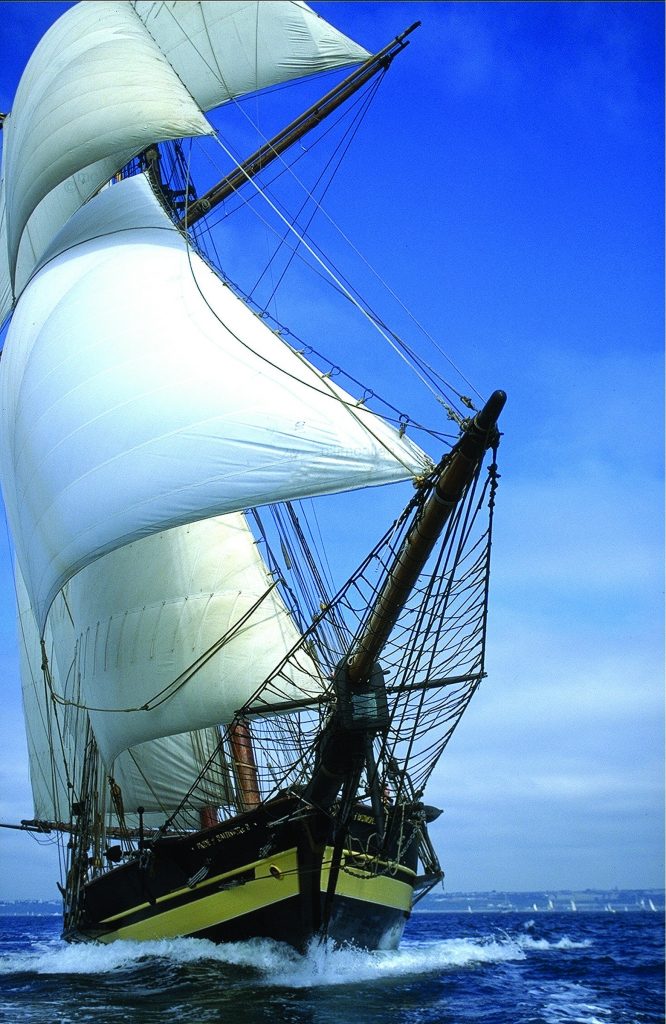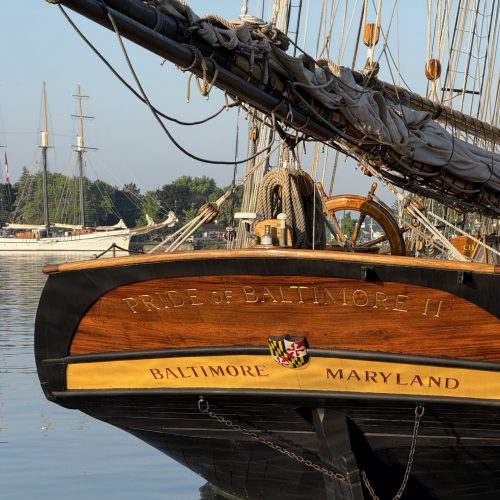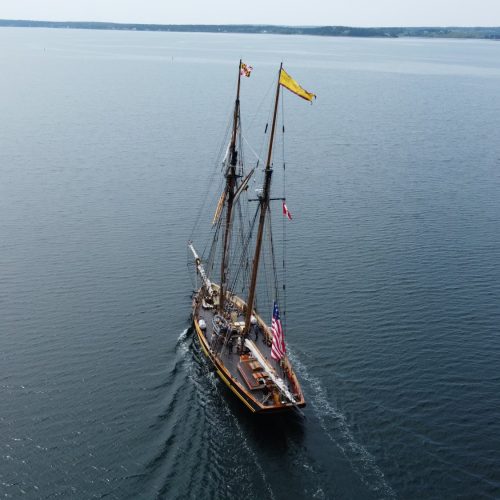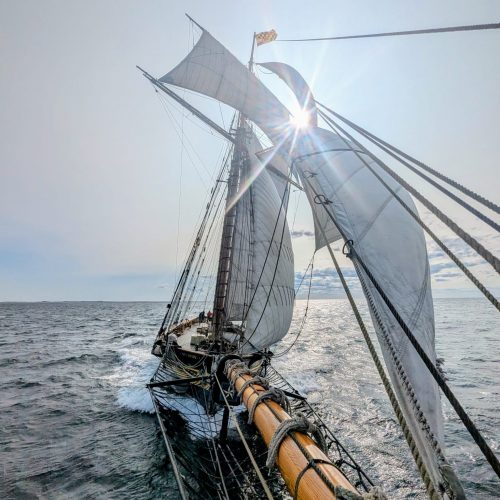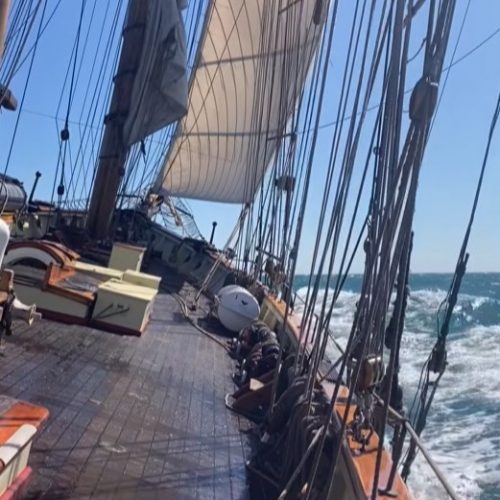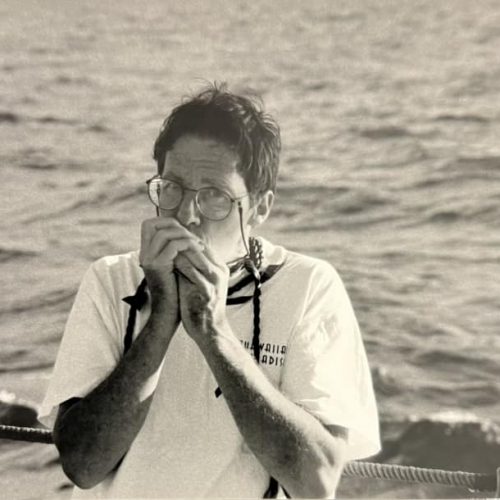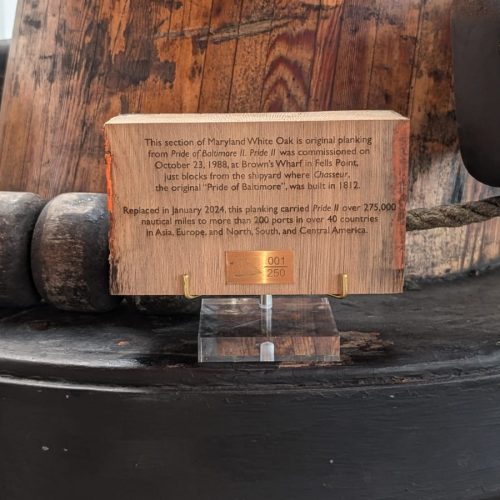SYNOPSIS: A thrash to windward for the fleet. Really hard work for PRIDE’s crew during the tacks. Big sails to trim in fresh wind. Fortunately only four tacks for the race. Great accomplishment PRIDE being second in fleet to cross the finish line…ahead of all but one of the smaller but much narrower more modern style A Class fleet that usually handles going to windward with a smile as they stretch their lead on the AA Class. But not this time.
PRIDE did well in the race. Although this opinion is a pretty subjective one. On the face of it, at first glance, PRIDE was beaten by the venerable crew of WOODWIND of Annapolis. But PRIDE led the rest of the sixteen “bigger” boats of both AA Class and A Class across Thimble Light Shoal finish line. Being the second vessel in fleet to cross the finish line is actually quite an accomplishment when one considers the weather pattern and PRIDE’s vessel type as compared to other vessels.
The weather pattern was mostly from the south…or in sailing vessel terms…right on the bow for the direction needing to go. As a result much of the race was a “beat to windward”. For some it was more a thrash.
What is a beat to windward? In moderate to light winds the experience is not much to talk about except while racing one wants to do it very efficiently so any flaw in the wind is attentively and promptly dealt with keeping the vessel sailing as quickly as possible as closely to the wind as possible. In fresh winds the experience of beating to windward can be just that, a bashing experience. Bashing steeply leaning hulls over sizable waves made by the fresh wind. On top of which is the effort by crews to deal with sails so full of wind that any adjustment takes significant effort. A quite exhausting effort in vessels that do not have modern mechanical devices such as winches with the power of one person being made “adequate” to handle whatever the sheet of a sail is presenting for resistance. PRIDE’s crew are always faced with “large” sails and only 4-part block & tackle…or less…to trim sails of not less than 700 square feet…more often 1,000-1,500 square feet. Most of which are not self-tacking. But must be un-sheeted on one side and sheeted in on the other side for each tack…just as modern jibs are released and hauled back-in when tacking to windward. Put PRIDE’s sails in 18 knots of wind and add boat speed of 6-8 knots almost directly into the wind and the strain to overcome is that created by nearly 25 knots of relative wind strength. Fortunately for the crew, there were only four tacks for PRIDE going down The Bay. None of them less than an hour between tacks. So crew rest was quite feasible. We have known times in other races of only twenty minutes between tacks.
The vessels racing the full length of The Bay and across the latitude line of Thimble Shoal Light as the finish line are divided into two classes. AA Class and A Class. The differences between the two classes is the “rated” length plus the perception of “old” style “tall ship” type verses the “newer” classic “yacht” type of vessel. Interestingly the classification difference can also be expressed in the beam to length ratio of the vessels of these two classes. While AA Class is initially established by being longer than A Class, hence also expected to be faster due to being longer, it is also clearly a ‘wider vessel for length’ class than the A Class vessels. Notwithstanding the division between classes by rated length hence expected speed performance as well the difference in appearance of type…the most commonly consequential difference of performance between the classes is caused by the beam to length ratio. Creating the odd counter intuitive result of A Class most often being faster than AA Class, notwithstanding being shorter in rated length hence supposedly slower.
A wider vessel for length is generally not expected to be as speedy as a narrower vessel for similar length. Most particularly when beating to windward. Meanwhile longer vessels are expected to be faster than shorter vessels due to the physics of displacement hulls in water as expressed by a formula for “hull speed”. In spite of the rule of Hull Speed for displacement vessels there are many examples of narrow beam to length vessels going faster than longer vessels of similar beam to length ratios because those longer vessels are also heavier due to larger size and may not have the sail area to length power ratio the smaller vessel has hence the longer “narrow” vessel can be slower to accelerate. Until wind strength builds to a level strong enough for the shorter vessels to be unable to keep going ever faster due to the limit of the hull speed rule, the longer heavier vessels find it difficult to get closer to their hull speed potential hence begin to go faster than the quicker to accelerate shorter vessels. Sailing in a narrow body of water where all sail vessels must tack against the wind to go the length of that body of water will create an advantage to the narrow & smaller & quicker to maneuver & accelerate vessel over a larger & wider heavier & slower to maneuver vessel. This difference can sometimes be overcome by the larger vessel making fewer tacks well spread apart in distance enabling getting up to their higher longer hull enabled speed and holding such speed for longer.
PRIDE crossed the finish line ahead of all but one of the A Class (shorter narrower beam to length) vessels. In wind that kicked up a decent wave height in certain areas of The Bay. So even PRIDE was doing a little bashing into the waves. Such activity can slow a vessel down if not carefully managed by fine tuning the angle of the vessel to the wind so that enough power can be found to bash through the seas while not giving much away to loss of direction through not sailing as close to the wind as otherwise feasible.
Of all the shorter, quicker Class A vessels WOODWIND did the best job of keeping up boat speed to windward and into the waves hence was the first vessel to cross the finish line. PRIDE did the second best job notwithstanding being heavier and wider than most of the fleet. The rating PRIDE is assigned indicates that PRIDE ought to be faster than all of the Class A vessels. However that is an idealized concept. The relative efficiency of all of the vessels as indicated by the handicap is compromised when beating to windward. The narrower beam to length vessels loss of efficiency is more moderate than the loss to the “wider” beam to length AA Class vessels. However PRIDE managed to overcome her inefficiencies beating to windward well enough to physically lead all but one of the A Class vessels across the finish line. Had the wind been “free”, meaning fair for pointing PRIDE down the race course without having to sail close to the wind, it might be possible for her to sail to her rating and not only beat all of A Class physically, but also in terms of her handicap. But I know from experience that is only possible when the wind is pretty strong and pretty far behind the fleet enabling PRIDE’s higher hull speed to pass the lower hull speeds of the shorter & narrow vessels of A Class. Interestingly this is not generally possible for PRIDE when the wind is directly behind. When the wind is directly behind, it has proven a benefit to her sister AA Class vessels because they are able to go “wing & wing” when PRIDE cannot due to her eccentric rig characteristics. Also the other AA Class vessels are often shallower and often with a centerboard they can pull up to reduce drag. In dead downwind conditions PRIDE has been beaten by the ratings of other AA Class vessels while still being the first in her class to sail across the finish line. Even when she has physically been first in the whole fleet crossing the finish line her class sisters have “caught” her by virtue of their handicaps.
Anyway, back to this race. All the fleet battled with head winds and bouncy seas. Some better than others. I am more than satisfied knowing PRIDE did rather well being the second vessel in the fleet to cross the finish line in a beat to windward race while being one of the less efficient old style tall ship type vessels hence both “fatter” as well a lot heavier than both her class as well the A Class vessels. Doing so while sailing with the second oldest period style rig in the whole fleet. The oldest period style rig goes to SULTANA being she is of the Colonial America period. Meanwhile, quite a lot of PRIDE’s success for this race goes to the assistance of a superior mariner and friend as well past Chief Mate of PRIDE’s earliest sailing years. Lifelong Baltimorean Mark Roesner and his wife Terry accepted my invitation to assist me with the race. Mark was key to keeping PRIDE going well to windward through great headsail trim plus steady helming her to windward.
As I write this, PRIDE OF BALTIMORE II remains in Portsmouth, Virginia awaiting northerly winds to shift to southwesterly forecast to occur overnight and remain for the whole of Tuesday the full length of the Chesapeake Bay. Seems like an opportunity to sail comfortably and easily up The Bay tomorrow. As a result the crew are today attending to ship care. Rig inspection, general wear & tear maintenance of rig & cosmetics, ship-familiarization orientation of a new deckhand, routine maintenance of engineering as well start-up of our “friendly” galley cast iron diesel fuel cooking stove “Chernobyl” as a way to heat the down below in the midst of the first cold spell of the coming winter.
Post Great Chesapeake Bay Schooner Race recovery by all hands is accomplished…or so I believe. No telling with a young crowd. Early to sleep can be hard for them. Even when tired. We all needed the opportunity for a lot of rest. Everyone got some rest during the race. But it was not long rest. And when they were not resting there was pulling on lines for a tack or reduction of sail or setting of sail as the wind patterns changed strength and relative angle to the ship.
My compliments to PRIDE’s crew and the whole fleet for a well fought thrash to windward down the Great Chesapeake Bay.

